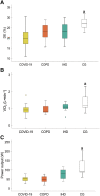Severe loss of mechanical efficiency in COVID-19 patients
- PMID: 34102017
- PMCID: PMC8242734
- DOI: 10.1002/jcsm.12739
Severe loss of mechanical efficiency in COVID-19 patients
Abstract
Background: There is limited information about the impact of coronavirus disease (COVID-19) on the muscular dysfunction, despite the generalized weakness and fatigue that patients report after overcoming the acute phase of the infection. This study aimed to detect impaired muscle efficiency by evaluating delta efficiency (DE) in patients with COVID-19 compared with subjects with chronic obstructive pulmonary disease (COPD), ischaemic heart disease (IHD), and control group (CG).
Methods: A total of 60 participants were assigned to four experimental groups: COVID-19, COPD, IHD, and CG (n = 15 each group). Incremental exercise tests in a cycle ergometer were performed to obtain peak oxygen uptake (VO2 peak). DE was obtained from the end of the first workload to the power output where the respiratory exchange ratio was 1.
Results: A lower DE was detected in patients with COVID-19 and COPD compared with those in CG (P ≤ 0.033). However, no significant differences were observed among the experimental groups with diseases (P > 0.05). Lower VO2 peak, peak ventilation, peak power output, and total exercise time were observed in the groups with diseases than in the CG (P < 0.05). A higher VO2 , ventilation, and power output were detected in the CG compared with those in the groups with diseases at the first and second ventilatory threshold (P < 0.05). A higher power output was detected in the IHD group compared with those in the COVID-19 and COPD groups (P < 0.05) at the first and second ventilatory thresholds and when the respiratory exchange ratio was 1. A significant correlation (P < 0.001) was found between the VO2 peak and DE and between the peak power output and DE (P < 0.001).
Conclusions: Patients with COVID-19 showed marked mechanical inefficiency similar to that observed in COPD and IHD patients. Patients with COVID-19 and COPD showed a significant decrease in power output compared to IHD during pedalling despite having similar response in VO2 at each intensity. Resistance training should be considered during the early phase of rehabilitation.
Keywords: COPD; Cardiopulmonary exercise test; Ischaemic heart disease; Muscular dysfunction; SARS-CoV-2.
© 2021 The Authors. Journal of Cachexia, Sarcopenia and Muscle published by John Wiley & Sons Ltd on behalf of Society on Sarcopenia, Cachexia and Wasting Disorders.
Conflict of interest statement
All authors declare no competing interests.
Figures


Similar articles
-
Low resting diffusion capacity, dyspnea, and exercise intolerance in chronic obstructive pulmonary disease.J Appl Physiol (1985). 2019 Oct 1;127(4):1107-1116. doi: 10.1152/japplphysiol.00341.2019. Epub 2019 Aug 1. J Appl Physiol (1985). 2019. PMID: 31369329
-
Persistent Exertional Intolerance After COVID-19: Insights From Invasive Cardiopulmonary Exercise Testing.Chest. 2022 Jan;161(1):54-63. doi: 10.1016/j.chest.2021.08.010. Epub 2021 Aug 11. Chest. 2022. PMID: 34389297 Free PMC article.
-
Ventilatory requirements of quadriceps resistance training in people with COPD and healthy controls.Int J Chron Obstruct Pulmon Dis. 2014 Jun 5;9:589-95. doi: 10.2147/COPD.S59164. eCollection 2014. Int J Chron Obstruct Pulmon Dis. 2014. PMID: 24940055 Free PMC article.
-
The impact of exercise training intensity on change in physiological function in patients with chronic obstructive pulmonary disease.Sports Med. 2006;36(4):307-25. doi: 10.2165/00007256-200636040-00003. Sports Med. 2006. PMID: 16573357 Review.
-
Determinants of cardiorespiratory fitness measured by cardiopulmonary exercise testing in COVID-19 survivors: a systematic review with meta-analysis and meta‑regression.Braz J Phys Ther. 2024 Jul-Aug;28(4):101089. doi: 10.1016/j.bjpt.2024.101089. Epub 2024 Jun 17. Braz J Phys Ther. 2024. PMID: 38936313 Free PMC article.
Cited by
-
Ultrasound imaging assessment of the diaphragm and abdominal muscles in people with a recent history of moderate Covid-19 infection and healthy participants: A cross-sectional pilot study.PLoS One. 2023 Feb 10;18(2):e0281098. doi: 10.1371/journal.pone.0281098. eCollection 2023. PLoS One. 2023. PMID: 36763588 Free PMC article.
-
Long-term impact of SARS-CoV-2 infection on cardiorespiratory fitness: a meta-analysis.Front Public Health. 2023 Oct 18;11:1215486. doi: 10.3389/fpubh.2023.1215486. eCollection 2023. Front Public Health. 2023. PMID: 37920575 Free PMC article.
-
Histopathological analysis of respiratory muscles in patients with acute COVID-19 infection.Cell Tissue Res. 2025 Jul;401(1):59-68. doi: 10.1007/s00441-025-03973-3. Epub 2025 May 5. Cell Tissue Res. 2025. PMID: 40323407 Free PMC article.
-
Impaired pulmonary and muscle function during moderate exercise in female patients recovered from SARS-CoV-2.Sci Rep. 2022 Dec 4;12(1):20943. doi: 10.1038/s41598-022-24941-9. Sci Rep. 2022. PMID: 36464697 Free PMC article.
-
Physical exercise-related manifestations of long COVID: A systematic review and meta-analysis.J Exerc Sci Fit. 2024 Oct;22(4):341-349. doi: 10.1016/j.jesf.2024.06.001. Epub 2024 Jun 16. J Exerc Sci Fit. 2024. PMID: 39022666 Free PMC article. Review.
References
-
- Actualización no 245. Enfermedad por el coronavirus (COVID‐19) https://www.mscbs.gob.es/profesionales/saludPublica/ccayes/alertasActual... Accessed November 7th 2020)

